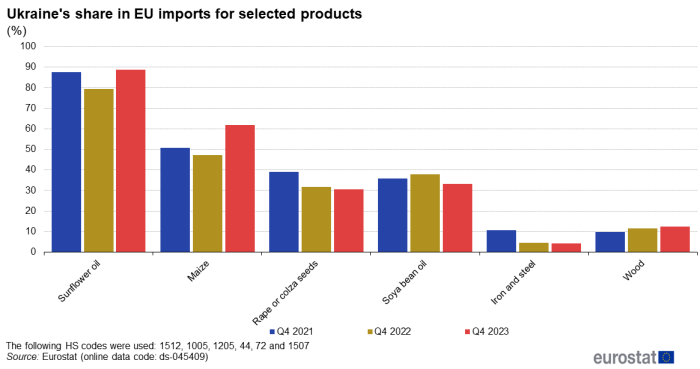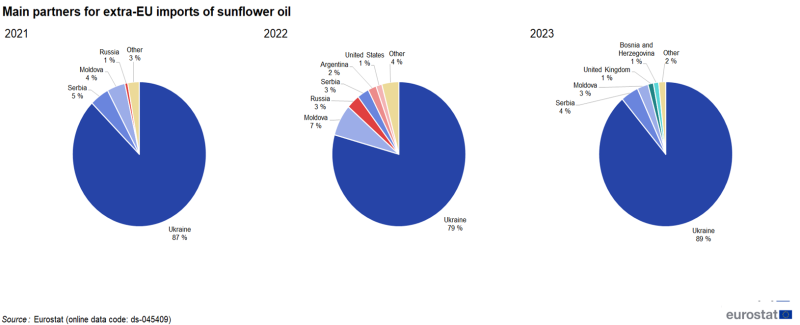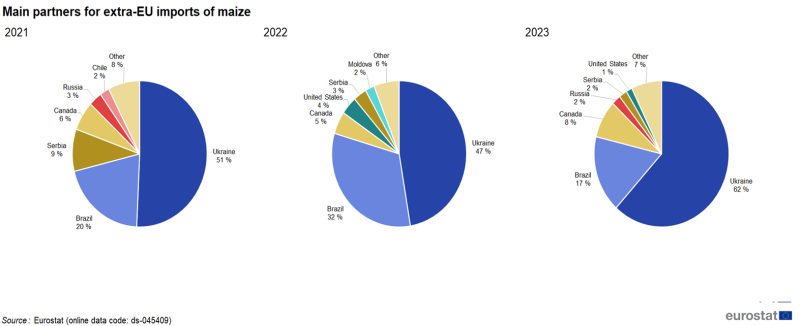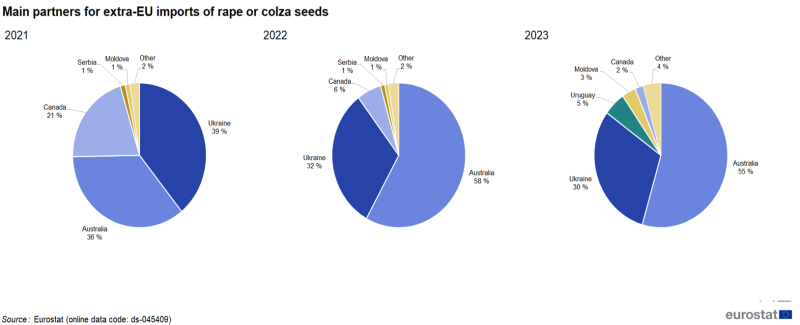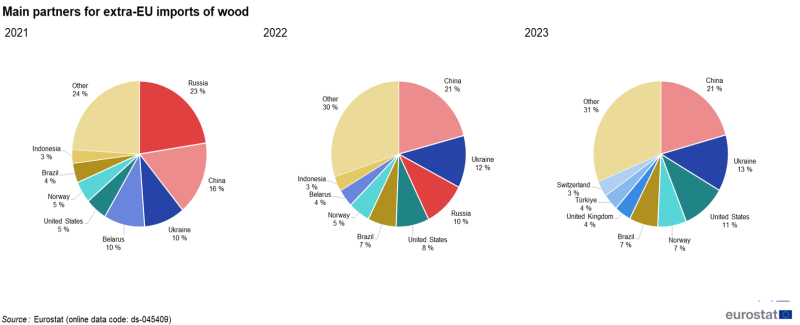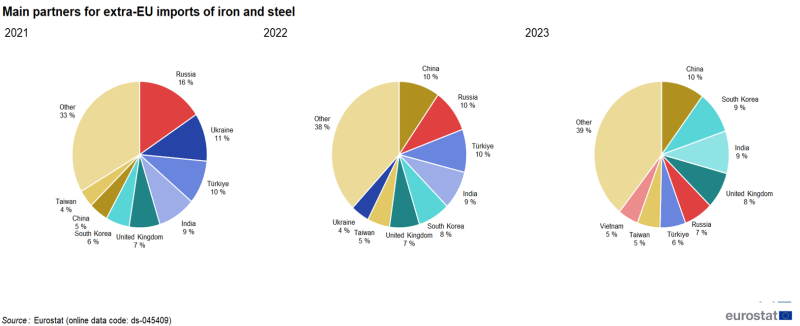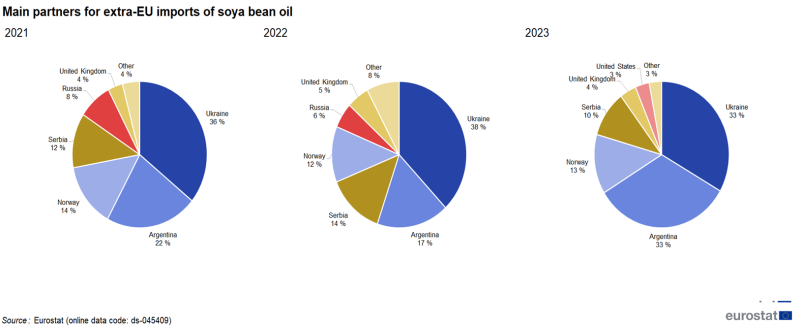EU trade with Ukraine - latest developments
Data extracted in February 2024
Planned article update: 30 May 2024
Highlights
This article shows how the trade between the European Union (EU) and Ukraine was disrupted by Russia's invasion of Ukraine. More general information on trade with Ukraine is available in ![]() this excel file. This article is part of an online publication providing recent statistics on international trade in goods, covering information on the EU's main partners, main goods traded, specific characteristics of trade as well as background information.
this excel file. This article is part of an online publication providing recent statistics on international trade in goods, covering information on the EU's main partners, main goods traded, specific characteristics of trade as well as background information.
Full article
Latest developments
In the fourth quarter of 2023, imports from Ukraine (€5.5 billion) were lower than in the same quarter in 2022 (€7.9 billion) while exports increased from €8.8 billion to €10.0 billion (Figure 1) in this period. Imports peaked in the second quarter of 2022, while exports peaked in the second quarter of 2023. This caused the EU trade surplus with Ukraine to peak in the fourth quarter of 2023 at €4.5 billion.
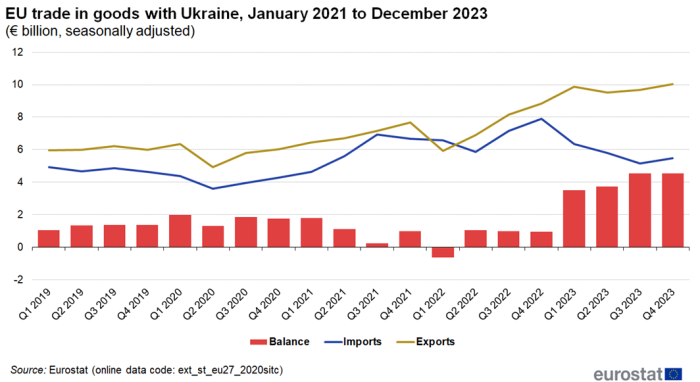
(€ billion, seasonally adjusted)
Source: Eurostat (ext_st_eu27_2020sitc)
When looking at the changes in Ukraine's shares in extra-EU trade, there was little variation (Figure 2). Import shares fluctuated between 0.8 % and 1.1 % while export shares fluctuated between 1.1 % and 1.3 %.
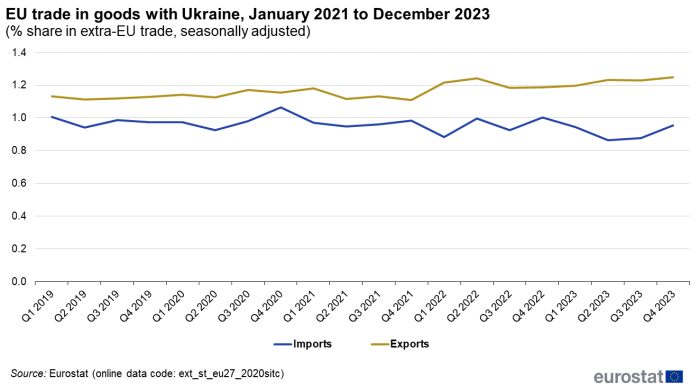
(share in extra-EU trade)
Source: Eurostat (ext_st_eu27_2020sitc)
Key product groups imported by the EU from Ukraine
This section focuses on six products that were selected because of their share in total extra-EU imports or their absolute value. Because several of these products have a strong seasonal component, they can only be analysed meaningfully over 12-month periods.
The EU has adopted a regulation allowing for temporary full trade liberalisation and the suspension of trade defence measures on 4 June 2022, resulting in a sharp increase in EU imports from Ukraine for several agricultural products. This caused distortions in markets for these products in countries neighbouring Ukraine, leading to the imposition of temporary restrictive measures on a series of Ukrainian foodstuff exports on 2 May 2023. These measures ended on 15 September 2023 while at the same time Ukraine was to put in place effective measures to control the export of these products[1]. It is important to keep these measures in mind when reading this article.
Figure 3 illustrates the share of six selected products in 2021, 2022 and 2023. In the 2023, compared with 2022, the shares for imports from Ukraine of maize, sunflower oil and wood increased while shares for soya bean oil, rape seeds and iron and steel decreased.
In the following sections, the evolution of EU imports for all six products is presented in terms of value, volume and unit value. In addition, the shares in imports by partner are shown for three consecutive 12-month periods.
EU imports of sunflower oil
In December 2023, EU imports of sunflower oil from Ukraine, measured in volume, were 8 percentage points (pp) above the level in December 2021. But since unit prices had dropped strongly their value dropped by 34 pp. EU imports of sunflower oil follow the same monthly pattern, in terms of trade value and volume, which is strongly connected to their production period (Figure 4). However, Russia's invasion led to a sharp increase in unit values between March and April 2022, with a change of 45 pp (from 151.8 % in March 2022 to 199.2 % in April 2022). Unit values went down progressively after June 2022.

value, indexed at 100 in January 2021
Source: Eurostat (ds-045409)
Between 2021 and 2023, Ukraine's share in the extra-EU imports of sunflower oil increased from 87 % to 89 %.
EU imports of maize
In December 2023, EU imports of maize from Ukraine, measured in volume, were 2 pp below the level in December 2021 (Figure 6). Since unit prices had dropped by 7 pp their value dropped by 12 pp. Similarly to sunflower oil, the infra-annual developments of EU imports of maize are visible in the value and volume index, with imports peaking in January and February 2022 and then again in November 2022. The unit values of maize increased between January 2021 and September 2021. A large drop followed in the next two months after which the unit values gradually increased, peaking in November 2022. Since then unit values gradually decreased.

value, indexed at 100 in January 2021
Source: Eurostat (ds-045409)
Between 2021 and 2023, Ukraine's share in the extra-EU imports of maize increased from 51 % to 62 % (Figure 7). Throughout this period, Brazil was the second largest partner for maize imports.
EU imports of rape/colza seeds
In December 2023, EU imports of rape or colza seeds from Ukraine, measured in volume, were 221 pp above the level of December 2021. Since unit prices had dropped by 47 pp their value increased by 49 pp (Figure 8). EU imports of rape/colza seeds from the Ukraine have a strong seasonal component, taking place mostly between August and November.

value, indexed at 100 in January 2021
Source: Eurostat (ds-045409)
Between 2021 and 2023, Ukraine's share in the extra-EU imports of rape or colza seeds decreased from 39 % to 30 % (Figure 9). This meant that Australia became the largest import partner, since its share increased from 36 % to 55 %.
EU imports of wood
In December 2023, EU imports of wood from Ukraine, measured in volume, decreased by 7 pp compared with the level of December 2021. Since unit prices had dropped by 35 pp their value dropped by 40 pp (Figure 12). The unit price for the EU's imports of wood increased between January 2021 and March 2022 but since then gradually dropped.

value, indexed at 100 in January 2021
Source: (ds-045409)
Between 2021 and 2023,, Ukraine's share in the extra-EU imports of wood increased from 10 % to 13 % (Figure 11). This made it the second largest supplier of wood to the EU behind China whose share had increased from 16 % to 21 % in this period.
EU imports of iron and steel
In December 2023, EU imports of iron and steel from Ukraine, measured in volume, decreased by 45 pp compared with the level of December 2021. However, since unit prices had dropped by 41 pp their value dropped by 94 pp (Figure 12). Both volume and value of the EU's imports of iron and steel from Ukraine increased strongly in the beginning of 2021 as demand and unit values increased following the economies' gradual recovery from the COVID-19 pandemic. Imports declined in late 2021, and did not return to pre-Russian invasion levels.

value, indexed at 100 in January 2021
Source: Eurostat (ds-045409)
Between 2021 and 2023, Ukraine's share in the extra-EU imports of iron and steel decreased from 11 % to 4 % (Figure 11). By contrast, the share of China increased by +5 pp making it the largest partner. The share of Russia dropped from 16 % to 7 %, as a consequence of the EU sanctions.
EU imports of soya bean oil In December 2023, EU imports of soya bean oil from Ukraine, measured in volume, were 77 pp above the level of December 2021. Since unit prices had dropped by 54 pp their value decreased by 6 pp (Figure 14). The volume and value of extra-EU imports of soya bean oil from Ukraine fluctuated strongly between January 2021 and December 2023. Unit values increased between January 2021 and June 2022 but had returned to slightly below January 2021 levels in December 2023.

value, indexed at 100 in January 2021
Source: Eurostat (ds-045409)
Between 2021 and 2023, Ukraine's share in the extra-EU imports of soya bean oil decreased from 36 % to 33 % (Figure 11). In the same period, the share of Argentina increased from 22 % to 33 %, keeping it the second largest partner for EU imports of soya bean oil.
Main product groups in EU exports to Ukraine
Ukraine was an important partner for EU exports of a number of products. Figure 16 shows the product groups with the highest share for Ukraine in EU exports. In the fourth quarter of 2023 compared with the fourth quarter of 2021 the largest increase was for raw hides, skins and leather while the largest drop was observed for fertilisers.
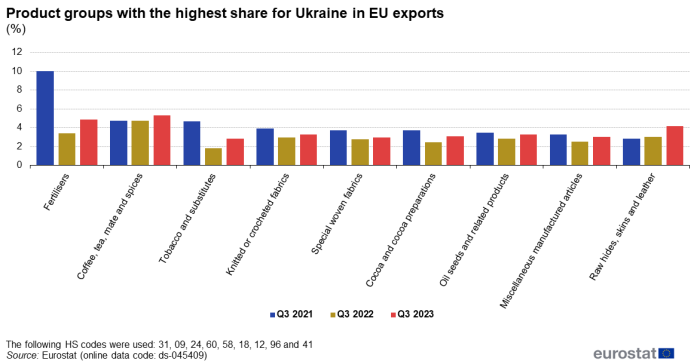
Source: Eurostat (ds-045409)
At a more aggregated level, in value terms, the largest product groups exported to Ukraine in the first quarter of 2021 were fuels, electrical machinery, vehicles, machinery and plastics - see Table 1. Between the first quarter of 2021 and the fourth quarter of 2023 exports of all these five products increased, most notably for fuels (+€ 1.4 billion, 457 %), vehicles (+€0.5 billion, 69 %) and electrical machinery (+€ 0.4 billion, 67 %) increased. The volume of these exports is shown in Table 2.

(€ million, quarterly data)
Source: Eurostat (ds-045409)

(1 000 tonnes, quarterly data)
Source: Eurostat (ds-045409)
Source data for tables and graphs
Data sources
EU data is taken from Eurostat's COMEXT database. COMEXT is the reference database for international trade in goods. It provides access not only to both recent and historical data from the EU Member States but also to statistics of a significant number of non-EU countries. International trade aggregated and detailed statistics disseminated via the Eurostat website are compiled from COMEXT data according to a monthly process.
Data are collected by the competent national authorities of the EU Member States and compiled according to a harmonised methodology established by EU regulations before transmission to Eurostat. For extra-EU trade, the statistical information is mainly provided by the traders on the basis of customs declarations.
EU data are compiled according to EU guidelines and may, therefore, differ from national data published by the Member States. Statistics on extra-EU trade are calculated as the sum of trade of each of the 27 EU Member States with countries outside the EU. In other words, the EU is considered as a single trading entity and trade flows are measured into and out of the area, but not within it.
Methodology
According to EU concepts and definitions, extra-EU trade statistics (trade between EU Member States and non-EU countries) do not record exchanges involving goods in transit, placed in a customs warehouse or given temporary admission (for trade fairs, temporary exhibitions, tests, etc.). This is known as 'special trade'. The partner is the country of final destination of the goods for exports and the country of origin for imports.
Product classification
Information on commodities exported and imported is presented according to the Harmonised System for product classification. A full description is available from Eurostat's classification server [1].
Unit of measure
Trade values are expressed in millions or billions (109) of euros. They correspond to the statistical value, i.e. to the amount which would be invoiced in case of sale or purchase at the national border of the reporting country. It is called a FOB value (free on board) for exports and a CIF value (cost, insurance, freight) for imports.
Context
Trade is an important indicator of Europe's prosperity and place in the world. The bloc is deeply integrated into global markets both for the products it sources and the exports it sells. The EU trade policy is one of the main pillars of the EU's relations with the rest of the world.
Because the 27 EU Member States share a single market and a single external border, they also have a single trade policy. EU Member States speak and negotiate collectively, both in the World Trade Organisation, where the rules of international trade are agreed and enforced, and with individual trading partners. This common policy enables them to speak with one voice in trade negotiations, maximising their impact in such negotiations. This is even more important in a globalised world in which economies tend to cluster together in regional groups.
The openness of the EU's trade regime has meant that the EU is the biggest player on the global trading scene and remains a good region to do business with. Thanks to the ease of modern transport and communications, it is now easier to produce, buy and sell goods around the world which gives European companies of every size the potential to trade outside Europe.
Direct access to
